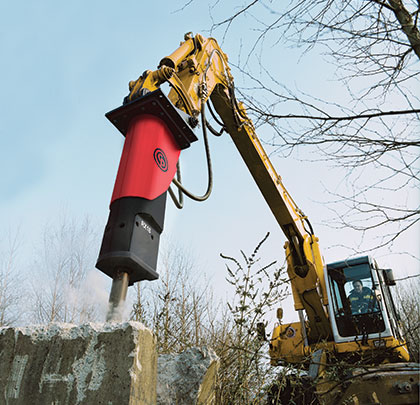Proper maintenance for a rig-mounted hydraulic breaker is extremely important to guarantee the longevity of a machine, which ultimately impacts a company’s bottom line. When it comes to caring for a rig-mounted breaker, the approach should be two-fold: maximizing performance through proper use in the field and setting up a hands-on preventive maintenance schedule. The combination of these two practices will lead to a long, productive life for a rig-mounted hydraulic breaker.
IN THE FIELD
Operators can do a few things to make sure they are capitalizing on their equipment investment. Proper use of the tool in everyday operations can ensure contractors are minimizing repairs later down the road.
It is not uncommon for operators to use a hammer on the breaker to pry concrete or rock into a better position. This is one of the worst practices an operator can engage in for keeping the breaker in optimal condition. Using a hammer as a prybar causes serious damage. The tool can become misaligned and rub against the bushing, causing unnecessary wear to important components.
It is a good practice to encourage operators to get to know their equipment before taking it to a jobsite. If an operator is comfortable with the breaker, there will most likely be fewer maintenance-related incidents in the field. Inexperienced operators should take some time to learn how the equipment works and how to use it before getting behind the controls.
Another important measure to take in the field is to only use the breaker in short bursts. Running the tool continuously for more than 15 to 25 seconds can cause extreme heat buildup, which will warp the tool and ultimately decrease performance and productivity. Additionally, if the target material is not breaking after 15 to 25 seconds, chances are that it won’t break without repositioning the material and/or the breaker tip. These few seconds of rest between operations are crucial to the integrity of the tool.
Seasoned operators know that blank firing is also a common mistake in the field that can affect the longevity of the breaker. Knowing how to avoid blank firing is something that can only be learned after many hours behind the controls. Blank firing commonly occurs right after material is broken; it is basically the tool firing against itself since there is no material underneath. The force from the blow has to go somewhere and if the rock or concrete is not absorbing it, the breaker ends up absorbing the force. That can cause unnecessary wear to the components. Some manufacturers offer a feature on their breakers that can reduce the occurrence of blank firing. For instance, our RX breaker line offers the Power Stop function to help protect the tool.

ESTABLISHING A MAINTENANCE PLAN
The second part of ensuring that a rig-mounted hydraulic breaker has a long, productive life is to establish a proactive maintenance plan. Lubrication is hands-down, the most important process for maintaining a rig-mounted breaker. A lack of proper lubrication correlates to a shorter overall lifespan of the unit. To help contractors protect their investment, many manufacturers offer an automatic lubrication system.
The carrier’s hydraulic filter should be inspected and changed after 100 hours of use, if necessary. Clean hydraulic oil is key to maximizing the life of a breaker. At this 100-hour mark, it is also a good idea to perform a thorough check of the breaker and remove the components for a closer look. After the inspection, be sure to tighten all bolts to the required torque.
The next point of inspection for a breaker should be at around 1,000 hours, at which point the carrier’s hydraulic oil and oil filter will need to be changed. This is also a good opportunity for contractors to check the flow settings and adjust, if needed. A number of manufacturers will suggest inspection and replacement of the seals at this point as well.
SOUND OPERATION + PROACTIVE MAINTENANCE = A PRODUCTIVE MACHINE
A savvy operator and a comprehensive maintenance plan go a long way when it comes to maximizing the life of a rig-mounted hydraulic breaker. One practice without the other will not produce optimal results for the unit. It is the combination of proper use and proper care that extends the life of the breaker and ultimately puts more money back in your pockets. ■
About the Author
Greg Petherbridge works for Chicago Pneumatic Construction Equipment. For more information, visit www.cp.com/en.
Modern Contractor Solutions, January 2015
Did you enjoy this article?
Subscribe to the FREE Digital Edition of Modern Contractor Solutions Magazine!


